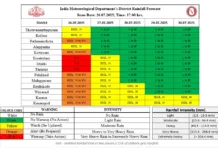
Hari Hara Veera Mallu: Part 1 – Sword vs Spirit
ONE WORD: A War, Lost to a Poor Script and Flat Execution
A Review by Arunjyothi R
RELEASE DATE: July 24, 2025
LANGUAGE: Telugu
DURATION: 2 Hours 47 minutes.
DIRECTOR: Krish Jagarlamudi and A. M. Jyothi Krishna
GENRE: Period Action Adventure
•POSITIVES:
1: Performance of Pawan Kalyan
2: Music and Background Score
3: Cinematography
4: Art Direction
5: Performance of Actors
•NEGATIVES:
1: Weak Direction
2: Poorly Written Script
3: Worst VFX
4: Unsatisfying Climax
5: Action Sequences
6: Mediocre Editing
STORY:
Veera Mallu (Pawan Kalyan) is a fearless rebel who takes from the rich to aid the poor, earning both admiration and enemies along the way. After outsmarting the King of Kollur and escaping with Panchami (Nidhhi Agerwal), his audacity captures the interest of Qutub Shah. Impressed by his daring, Shah assigns him a high-stakes mission — to steal the legendary Koh-i-Noor diamond from the powerful Mughal emperor Aurangazeb (Bobby Deol) in Delhi. But beneath the surface of this dangerous quest lies a deeper truth — Veera’s real mission is driven by a far greater purpose than anyone suspects.
REVIEW & ANALYSIS OF THE FILM:
Hari Hara Veera Mallu rides heavily on the shoulders of Pawan Kalyan, whose commanding presence is easily the film’s strongest asset. From his well-executed introduction to the few impactful close-up action shots, his performance remains the glue holding this historical drama together. The cinematography complements him well, especially during action sequences and character moments, enhancing his screen dominance. M. M. Keeravani’s background score also lends much-needed energy, especially during key scenes, preventing the film from sinking into complete dullness. The first half offers a few engaging elements — the heist angle, the interesting twist in Nidhhi Agerwal’s character, and a promising setup between Pawan Kalyan and Bobby Deol — all giving a glimpse of what the film could have been.
However, that early promise quickly fades as the second half unfolds. The narrative begins to wobble under the weight of a poorly constructed screenplay and immature direction. The storytelling lacks depth and emotional weight, with scenes feeling hollow and disjointed. What should have been dramatic or intense often ends up unintentionally comical. The writing fails to flesh out characters or build continuity, leaving the audience with half-baked arcs and a rushed, careless backstory. Instead of progressing with a gripping momentum, the second half drags with bloated sequences that add little to the plot.
The action choreography adds to the inconsistency, swinging between exaggerated stunts and misfired attempts at grandeur. Scenes like Pawan Kalyan battling trained wrestlers or chaotic war sequences fall flat due to poor staging and lack of believability. The film’s climax — clearly designed to tease a sequel — ends in near parody. The final 15 minutes, filled with laughably bad VFX and a bizarrely unconvincing face-off between Kalyan and Bobby Deol, leave the viewer bewildered rather than excited. Visual effects throughout the film suffer from poor quality, lack of polish, and a striking absence of realism, all the more frustrating given how crucial VFX was to the story’s scope.
While the art department deserves credit for impressive set design and authentic costumes that capture the 1650s setting, the film as a whole struggles to rise above mediocrity. The editing, though adequate in parts, fails to bring focus or momentum, especially in the dragging second half where several weak scenes could have been easily trimmed. With such a rich historical premise and a charismatic lead, Hari Hara Veera Mallu had immense potential — but unfortunately, it’s undermined by sloppy execution, a lackluster script, and a misfired sense of scale. What could have been an epic period adventure ends up feeling like a missed opportunity.
SO WHAT’S HOT:
1: What truly carried me through this otherwise tiring cinematic experience was Pawan Kalyan’s commanding performance. Despite the film’s sluggish pacing and underwhelming production quality, his screen presence remained the driving force that kept me invested right till the end.
2: The music and background score by M. M. Keeravani were among the film’s stronger aspects. His background music played a crucial role in preventing the film from becoming completely dull. In particular, the BGM used to enhance Pawan Kalyan’s screen presence was well-executed and added much-needed energy to several key moments.
3: The initial portion of the film proved to be more engaging compared to the less captivating second half. The introduction of Pawan Kalyan and Bobby Deol was skillfully done, leaving a positive impression. Furthermore, the heist plan and the unexpected turn in Nidhhi Agerwal’s character at the conclusion of the first half were also quite promising.
4: The cinematography was indeed commendable, effectively portraying the challenges of 1650 through well-composed frames and shots. Furthermore, the angles and close-up shots of Pawan Kalyan during the action sequences were expertly executed, enhancing his on-screen presence. .
5: The Art Department certainly did an excellent job. I was particularly impressed by the set arrangements, which effectively conveyed the atmosphere of the 1650s. The costumes in the film were also quite commendable.
6: The performances in the film were fairly decent, with nothing particularly disappointing to note. With a large ensemble cast, each actor managed to do justice to their respective roles, contributing well to the overall narrative.
SO WHAT DIDN’T WORK OUT:
1: I found that the direction of this film lacked depth, and the production appeared somewhat unsophisticated, which unfortunately diminished the cinematic experience for me. The direction seemed more akin to a drama, and it failed to create a compelling and engaging viewing experience.
2: The overall making of the film falls squarely into average scale. While the first half manages to stay afloat with some decent moments, the second half completely derails due to immature writing and weak direction. By the time it reaches the climax, the narrative becomes so chaotic and poorly handled that led me wondering what exactly is going on.
3: The final 15 minutes of the film, including its so-called climax, completely fell apart. Clearly designed to hint at a sequel or Part 2, these scenes unintentionally turned laughable. The VFX was poorly executed, bordering on comical, and the much-hyped face-off between Pawan Kalyan and Bobby Deol felt utterly disconnected from reality — leaving me wondering which universe this absurdity was meant to belong to. It was, quite frankly, a mess.
4: Whoever wrote the script for this film seriously needs to reconsider their approach to storytelling. The true villain here wasn’t a character — it was the disastrously written screenplay. Lacking emotion, depth, and coherence, the narrative failed to create any real engagement. Scenes felt hollow, continuity was inconsistent, character development was nearly nonexistent, and the backstory appeared rushed and carelessly thrown together. It was a textbook example of how not to write a screenplay.
5: The VFX in the film was nothing short of a disaster. Lacking proper sync and polish, it looked blatantly artificial and drained the film of any visual appeal. Given the nature of the story, which clearly demanded high-quality visual effects, the execution was deeply disappointing. It almost felt as if the VFX team was either rushed or completely out of depth. The climax, in particular, suffered the most — scenes that were meant to leave an impact ended up unintentionally comical. It’s baffling how such crucial sequences were handled with so little care.
6: The action sequences in this film are, at times, hard to take seriously. The choreography often leans towards the over-the-top, unintentionally shifting the tone from intense to unintentionally humorous. One particular scene—where Pawan Kalyan takes on a group of trained wrestlers—was so exaggerated it genuinely made me consider walking out of the theatre. The larger war sequences also fell flat, hindered by poorly designed action setups. That said, Pawan Kalyan’s introduction scene was a rare exception, handled with relatively decent choreography that offered a glimmer of promise early on.
7: The editing, while passable overall, lacked the sharpness needed to elevate the second half of the film. Several scenes in the latter portion felt unnecessarily stretched and could have easily been trimmed to improve pacing and engagement. A tighter edit might have made a significant difference in maintaining audience interest.
HOW ABOUT THE PERFORMANCE OF ACTORS:
Pawan Kalyan commands the screen with a performance that blends grace and star power. While the film struggles in many areas, it’s Pawan Kalyan’s screen presence that manages to keep things somewhat watchable. He brings a certain ease and confidence to the role of Veera Mallu, especially in the lighter scenes and action sequences. His dialogue delivery and charisma give the film brief moments of energy, even if the overall execution falls flat. It’s safe to say that without him, sitting through the film would’ve been a lot more difficult.
Bobby Deol shows up with a bang as the fierce Mughal emperor Aurangazeb, making a solid first impression with his intense presence. He’s introduced as a powerful, no-nonsense ruler, but surprisingly, he fades into the background as the film moves forward. It feels like a missed opportunity, though the setup clearly hints at a bigger role for him in a potential sequel — let’s just hope he gets more screen time next round.
Nidhhi Agerwal, playing Panchami, looked stunning and gorgeous on screen and also delivered a decent performance. Her character throws in a surprise twist midway through the film, which actually adds a bit of spark to the otherwise dragging storyline. Sathyaraj, as always, brings credibility and calm to his supporting role. The rest of the cast — Sunil, Subbaraju, Sachin Khedekar, Raghu Babu, Dalip Tahil, Anasuya Bharadwaj, Pujitha Ponnada, Kabir Bedi, Kabir Duhan Singh, and Makarand Deshpande — all do what’s needed, filling out the large world of the film without stealing too much spotlight.
HOW WAS THE MUSICAL DEPARTMENT?
One of the most noteworthy strengths of Hari Hara Veera Mallu is the music and background score composed by Oscar-winning maestro M. M. Keeravani. In a film that often struggles to hold the viewer’s attention, Keeravani’s compositions serve as a much-needed lifeline. With a total of five songs, the soundtrack offers brief moments of engagement amidst an otherwise uneven narrative. The music not only adds flavor but also brings a sense of rhythm and emotional weight where the screenplay fails to deliver.
Among the standout tracks, ‘Matta Vinaali’, sung by Pawan Kalyan himself, makes a strong impact with its heartfelt tone and meaningful placement. ‘Taara Taara’ impresses with its lively beats and does a fine job of showcasing Nidhhi Agerwal’s screen presence with visual elegance. ‘Kollagottinadhiro’ fits seamlessly within its scene, elevated by charming choreography featuring both Pawan Kalyan and Nidhhi Agerwal. These songs offer some of the film’s lighter and more enjoyable moments, breaking the monotony and adding a cultural texture to the film’s historical setting.
However, it’s the background score that truly anchors the film. Keeravani’s BGM helps elevate several scenes, particularly in the second half where the narrative begins to falter. His music brings intensity to action sequences, adds emotional depth to character moments, and injects a sense of scale that the film’s production often lacks. In many ways, Keeravani’s score acts as the emotional core of the film. It’s evident that he poured his expertise into salvaging the viewing experience, and without his contribution, the film would have struggled even more to stay afloat.
CONCLUSION:
Overall, Hari Hara Veera Mallu is a film that had the potential to be a grand historical action drama but ends up falling short due to weak writing, inconsistent direction, and disappointing visual effects. While M. M. Keeravani’s music and Pawan Kalyan’s screen presence provide occasional relief, they aren’t enough to fully carry the weight of a poorly structured narrative. Bobby Deol is underutilized, the second half completely loses steam, and the climax borders on unintentionally funny. There are a few decent moments — especially in the first half — and fans of Pawan Kalyan might still find it worth a watch just for him. But for the average viewer, this one’s a tough recommendation.
VERDICT: BELOW AVERAGE
RATING: 2/5
A Review by Arunjyothi. R



























